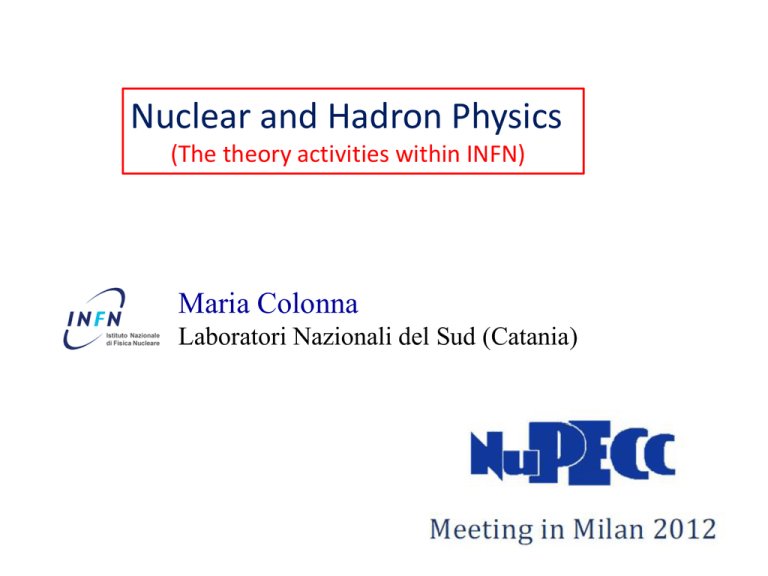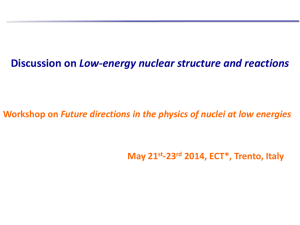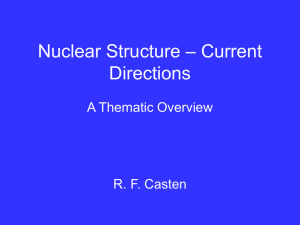M. Colonna
advertisement

Nuclear and Hadron Physics (The theory activities within INFN) Maria Colonna Laboratori Nazionali del Sud (Catania) Total FTE: 75 (Individuals ~100) INFN Postdoc : 8 PhD Students: 11 • Heavy Ion Collisions • QGP phenomenology • Neutron stars • Hadron Structure • Hadronic matter • Parton correlations Nuclear Matter EoS and Phases QCD Hadron Physics 38% 23% Nuclear Structure and Dynamics 39% • Few-body systems • Electro-weak probes • Shell model • Algebraic models • Mean-field and beyond • Reactions with exotic nuclei Nuclear matter EoS Heavy Ion Collisions QGP phenomenology Neutron stars Few-body systems Shell model Mean-field and beyond Reactions with exotic nuclei Hadron Structure Hypernuclei Collaborations with many Universities and Research Institutes spread around the world (France, Germany, Russia, Spain, … China, Japan, US…) Strong link with experimental activities (proposals, joint papers, PAC participation) in Italy, Europe, US, Japan… Organization of Workshops , Schools and Training of young scientists (ECT*, GGI) Hadron Physics Starting point: QCD The strong interaction sector of SM of elementary particles Open key questions: • Confinement ? • Structure of hadrons ? • What is the role of quarks and self-interacting gluons in nuclei ? Source: D.Lacroix Transversity parton distribution News on the Proton spin Semi-inclusive DIS e p e’ π X Anselmino et al., NPB 191,98(2009) Bacchetta et al. PRL 107, 012001 (2011) momentum fraction e + p e’ (π+ + π-) X Pavia and Torino groups • from HERMES • from COMPASS Q2 ~1-4 GeV2 From quarks to nucleons and nuclei - New trends in Nuclear Forces: Effective Field Theory: derive the nuclear force from QCD or QCD-inspired Lagrangians Few-body systems: Trento, Padova, Pisa Ab-initio calculations to study bound or scattering states Hyperspherical harmonics Lorentz Integral Transform (LIT) Trento group • Important final state interactions • Large effect of three-body force ! Shell model calculations: Napoli Use of modern Vlow-k Studies of exotic nuclei, high spin chiral potential 22C is the last bound isotope Coraggio et al, Phys.Rev. C81, 064303 (2010) Effective interactions and nuclear EoS ˆ E H ˆ H E ˆ eff Slater determinant Mean-field (MF), Effective interactions Source: F.Gulminelli Self-consistent MF calculations (and extensions) are a powerful framework to understand the structure of mediumNuclear levels heavy nuclei. Nuclear collective motion (linear response) Extrapolation to infinite nuclear matter: Equation of State (EoS) Microscopic methods are used to construct effective interactions and nuclear EoS: BHF, CBF, FHNC , AFDMC (Catania, Lecce, LNS, Roma, Trento) The concept or EoS is widely employed in the astrophysical context (modelization of neutron stars and supernova explosion) Properties of the crust, mass vs. radius, … Properties of single particle and collective states in (exotic) nuclei Milano group Particle-core coupling in 49Ca Probing the nature of particle-core coupling (PVC model) in odd nuclei with gamma spectroscopy and heavy-ion transfer reactions Experiment performed at LNL D.Montanari et al, Phys.Lett. B697 (2011) 288 Isovector dipole response New exotic collective modes : a way to test the density dependence of the symmetry energy E/A (ρ) = Es(ρ) + Esym(ρ) β² GDR β=(N-Z)/A - Pygmy Dipole Resonance (PDR): The strength is connected to the size of the neutron-skin Low density behavior of Esym PREX experiment (Neutron radius) at Jlab PDR Roca-Maza et al, PRC85,024601(2012) Neutron center Proton center of mass of mass Reaction dynamics: from nuclei to new phases of nuclear matter Matching of structure and reaction theories Role of Coulomb and nuclear potential in the excitation of PDR and GDR E (MeV) Matching EoS and transport theories Phenomenology of Heavy Ion Collisions at Intermediate Energies : a way to explore the Nuclear Matter phase diagram E.G.Lanza et al, PRC 84, 064602 (2011) Catania - Padova collaboration Reactions with very exotic nuclei, like transfer and break-up Two-particle transfer reactions as a probe of nuclear pairing TDHF (and extensions) Semi-classical approximation: time evolution of the LNS group one-body distribution function in phase space f(r,p,t): f f, H I coll t using effective interactions Advanced quantum models by Pisa and Padova groups DREB2012 E.De Filippo et al (Chimera coll), submitted Z Fragmentation events (35 MeV/A) Fragment N/Z: Experiment-Theory comparison Ultra-relativistic HIC and QGP Phenomenology Initial Conditions Quark-Gluon Plasma Hadronization BULK (pT~T) CGC (x<<1) Gluon saturation MINIJETS (pT>>T,LQCD) Microscopic Mechanism Matters! Heavy Quarks (mq>>T,LQCD) Hadron abundance: Statistical models works for all iniitial conditions: e+e-, pp, AA collisions Firenze: Hydrodynamical models Hadronization and statistical models Becattini, Castorina et al, Eur. Phys. J. C (2010) 66: 377–386 LNS: Partonic transport theories: a way to link QCD effective Lagrangians and lQCD predictions to exp. observables An example: Elliptic flow and QGP viscosity Torino: Strangeness suppression New exotic non-equilibrium phases (Color Glass Condensate) y z x A large variety of approaches and methods, but in several cases a common goal can be identified -ex. Exotic systems and symmetry energy Contiguity between nuclear and hadron physics -ex. New nuclear forces, transitions to new phases of matter in HIC and in neutron stars (hyperons, deconfined phase) Strong collaboration between experimentalists and theorists only in some sectors, however synergies are increasing and encouraged by INFN theoretical and experimental Committees Other funding MIUR-PRIN 2011-2013 1) Quark-Gluon-Plasma and high energy collisions Universities involved: Firenze (F.Becattini), Catania, Torino, Torino Politec. 2) Stucture and dynamics of nuclei beyond the valley of stability Universities involved: Padova (A.Vitturi), Catania, Napoli, Pavia, Trento MIUR-FIRB 2010-2014 QCD phases, field-theory models and transport theories: a systematic approach to the phenomenology of heavy ion collisions at LHC Catania Univ. (V.Greco) --- Torino Univ. (C.Ratti) • ERC --- Starting Grant 2011-2016 Dynamics of the Quark Gluon Plasma Catania Univ. (V.Greco) E.U.FP7 – I3HP2 Hadron Physics 2-3 (2008-2012) Study of Strongly Interacting Matter European Network + JRA (several INFN sites) New computing centers -2010 A single central cluster (Project CSN4cluster) in Pisa -128 nodes for serial and parallel jobs -Accessible via GRID -2011 “Memory driven” facility with high RAM/CORE ratio -Exploited by nuclear theorists 6-core, 32 GB RAM, 2 TB HD -Local access Incontro Nazionale di Fisica Nucleare 12-14 Novembre 2012, INFN-LNS Catania Comitato Promotore: C.Agodi (LNS) M.Colonna (LNS) A.Gargano (NA) P.Gianotti (LNF) A.Guglielmetti (LNGS) A.Kievsky (PI) Comitato Locale: S.Lenzi (PD) D.Napoli (LNL) M.Radici (PV) P.Rossi (LNF) E.Scapparone(BO) E.Vigezzi (MI) G.F.Burgio (CT) M. La Cognata (LNS) E.Lanza (CT) A.Musumarra (LNS) S.Pirrone (CT) G.Verde (CT)





![The Politics of Protest [week 3]](http://s2.studylib.net/store/data/005229111_1-9491ac8e8d24cc184a2c9020ba192c97-300x300.png)



